View in other NatureServe Network Field Guides
NatureServe
Montana
Utah
Wyoming
Idaho
Wisconsin
British Columbia
South Carolina
Yukon
California
New York
White Milkwort - Polygala alba
Native Species
Global Rank:
G5
State Rank:
S4
(see State Rank Reason below)
C-value:
Agency Status
USFWS:
USFS:
BLM:
External Links
State Rank Reason (see State Rank above)
Polygala alba is common throughout eastern Montana. Plants grow in habitats that are widespread and relatively secure. Plant populations can vary from occasional to abundant; yet, threats or factors that may limit populations or its distribution have not been identified.
- Details on Status Ranking and Review
Range Extent
ScoreF - 20,000-200,000 sq km (~8,000-80,000 sq mi)
Comment114,881 square kilometers.
Area of Occupancy
ScoreF - 126-500 4-km2 grid cells
CommentMontana can be divided into 30,390 4x4 square kilometer cells. For this species 232 plant observations occur in 192 of these 4x4 square kilometer cells.
Number of Populations
ScoreD - 81 - 300
Comment231 observations.
Number of Occurrences or Percent Area with Good Viability / Ecological Integrity
ScoreE - Many (41-125) occurrences with excellent or good viability or ecological integrity
Comment53 observations described as "common", "abundant", "11-101 plants per plot", or "101-500 plants per plot".
Environmental Specificity
ScoreC - Moderate. Generalist or community with some key requirements scarce
CommentPlants grow in grasslands and Ponderosa Pine woodlands.
General Description
PLANTS: Perennial plants that grow from a branched caudex. Stems are erect, singular, without hairs (glabrous), and 10–30 cm tall. Source: Lesica et al. 2012
LEAVES: Arranged in whorls or alternately on the stem. Leaf blades are simple with entire margin, linear to linear-oblanceolate in shape, without stipules, and 5–25 cm long. Source: Lesica et al. 2012
INFLORESCENCE: Spike-like and terminal. Flowers are white with a green center, contain both male and female organs (perfect), are irregular, and hypogynous. Sepals are 5 of which 2 are large and petal like while 3 are small. Petals are 3 and united below. Wing petals are 2-4 mm long. Lower petal is keel-shaped, 2-3 mm long with 4 lobes on each side. Stamens: 8. Ovary with a 2-lobed style. Fruit is a capsule. Source: Lesica et al. 2012
Diagnostic Characteristics
The flowers of
Polygala can resemble papilionaceous flowers which are characteristic for members of the Pea (Fabaceae) Family. Montana has 2
Polygala species:
White Milkwort -
Polygala alba, native and desirable
*Life Form: Perennial with a branched caudex.
*Leaves: Lower ones are alternate.
Whorled Milkwort -
Polygala verticillata, native and desirable
*Life Form: Annual with a taproot.
*Leaves: Lower ones are whorled.
Species Range
Montana Range
Range Descriptions
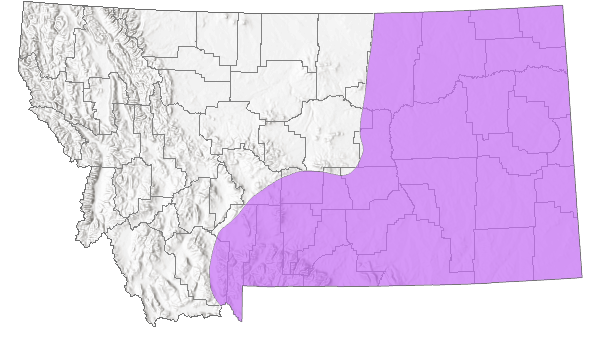
 Native
Native
Range Comments
Washington to Minnesota south to Arizona, Texas and Mexico (Lesica et al. 2012).
Observations in Montana Natural Heritage Program Database
Number of Observations: 366
(Click on the following maps and charts to see full sized version)
Map Help and Descriptions
Relative Density
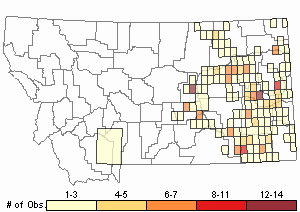
Recency
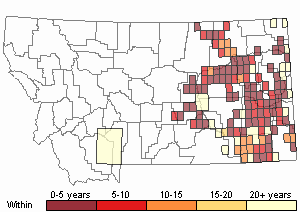

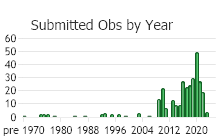
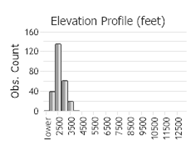 (Observations spanning multiple months or years are excluded from time charts)
(Observations spanning multiple months or years are excluded from time charts)
Habitat
In grasslands and ponderosa pine woodlands in the plains zone of Montana (Lesica et al. 2012).
Reproductive Characteristics
Plants reproduce by seed.
FRUITS
Capsule: ellipsoid, 2-celled (locules), and 2-3 mm long (Lesica et al. 2012). Seeds: 1 per cell and enclosed in an aril.
Stewardship Responsibility
References
- Literature Cited AboveLegend:
 View Online Publication
View Online Publication Lesica, P., M.T. Lavin, and P.F. Stickney. 2012. Manual of Montana Vascular Plants. Fort Worth, TX: BRIT Press. viii + 771 p.
Lesica, P., M.T. Lavin, and P.F. Stickney. 2012. Manual of Montana Vascular Plants. Fort Worth, TX: BRIT Press. viii + 771 p.
- Additional ReferencesLegend:
 View Online Publication
View Online Publication
Do you know of a citation we're missing? Anderson, N.L. 1951. Field studies on the biology of range grasshoppers of southeastern Montana. M.Sc. Thesis. Bozeman, Montana: Montana State University. 96 p.
Anderson, N.L. 1951. Field studies on the biology of range grasshoppers of southeastern Montana. M.Sc. Thesis. Bozeman, Montana: Montana State University. 96 p. DuBois, K.L. 1979. An inventory of the avifauna in the Long Pines of Southeastern Montana. M.Sc. Thesis. Bozeman, MT: Montana State University. 113 p.
DuBois, K.L. 1979. An inventory of the avifauna in the Long Pines of Southeastern Montana. M.Sc. Thesis. Bozeman, MT: Montana State University. 113 p. Fritzen, D.E. 1995. Ecology and behavior of Mule Deer on the Rosebud Coal Mine, Montana. Ph.D. Dissertation. Bozeman, MT: Montana State University. 143 p.
Fritzen, D.E. 1995. Ecology and behavior of Mule Deer on the Rosebud Coal Mine, Montana. Ph.D. Dissertation. Bozeman, MT: Montana State University. 143 p. King, L.A. 1980. Effects of topsoiling and other reclamation practices on nonseeded species establishment on surface mined land at Colstrip, Montana. M.Sc. Thesis. Bozeman, MT: Montana State University. 129 p.
King, L.A. 1980. Effects of topsoiling and other reclamation practices on nonseeded species establishment on surface mined land at Colstrip, Montana. M.Sc. Thesis. Bozeman, MT: Montana State University. 129 p. Lesica, P., M.T. Lavin, and P.F. Stickney. 2022. Manual of Montana Vascular Plants, Second Edition. Fort Worth, TX: BRIT Press. viii + 779 p.
Lesica, P., M.T. Lavin, and P.F. Stickney. 2022. Manual of Montana Vascular Plants, Second Edition. Fort Worth, TX: BRIT Press. viii + 779 p. Meier, G.A. 1997. The colonization of Montana roadsides by native and exotic plants. M.Sc. Thesis. Bozeman, MT: Montana State University. 45 p.
Meier, G.A. 1997. The colonization of Montana roadsides by native and exotic plants. M.Sc. Thesis. Bozeman, MT: Montana State University. 45 p. Rennick, R.B. 1981. Effects of prescribed burning on mixed prairie vegetation in southeastern Montana. M.Sc. Thesis. Bozeman, MT: Montana State University. 144 p.
Rennick, R.B. 1981. Effects of prescribed burning on mixed prairie vegetation in southeastern Montana. M.Sc. Thesis. Bozeman, MT: Montana State University. 144 p. Seipel, T.F. 2006. Plant species diversity in the sagebrush steppe of Montana. M.Sc. Thesis. Bozeman, MT: Montana State University. 87 p.
Seipel, T.F. 2006. Plant species diversity in the sagebrush steppe of Montana. M.Sc. Thesis. Bozeman, MT: Montana State University. 87 p.
- Web Search Engines for Articles on "White Milkwort"





